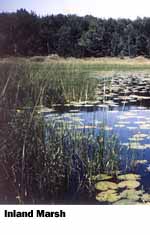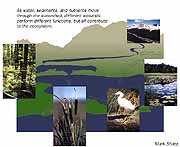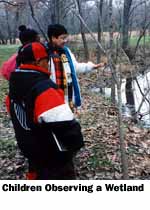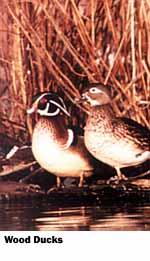|

 The
federal government protects wetlands through regulations (like
Section 404 of the Clean Water Act), economic incentives and
disincentives (for example, tax deductions for selling or donating
wetlands to a qualified organization and the "Swampbuster" provisions of
the Food Security Act), cooperative programs, and acquisition (for
example, establishing national wildlife refuges). You can find out more
about these mechanisms by calling the Wetlands Hotline
(1-800-832-7828). The
federal government protects wetlands through regulations (like
Section 404 of the Clean Water Act), economic incentives and
disincentives (for example, tax deductions for selling or donating
wetlands to a qualified organization and the "Swampbuster" provisions of
the Food Security Act), cooperative programs, and acquisition (for
example, establishing national wildlife refuges). You can find out more
about these mechanisms by calling the Wetlands Hotline
(1-800-832-7828).

 Beyond the federal
level, a number of states have enacted laws to regulate activities in
wetlands, and some counties and towns have adopted local wetlands
protection ordinances or have changed the way development is permitted.
Most coastal states have significantly reduced losses of coastal wetlands
through protective laws. Few states, however, have laws specifically
regulating activities in inland wetlands, although some states and local
governments have non-regulatory programs that help protect wetlands. Beyond the federal
level, a number of states have enacted laws to regulate activities in
wetlands, and some counties and towns have adopted local wetlands
protection ordinances or have changed the way development is permitted.
Most coastal states have significantly reduced losses of coastal wetlands
through protective laws. Few states, however, have laws specifically
regulating activities in inland wetlands, although some states and local
governments have non-regulatory programs that help protect wetlands.
 Recently, partnerships
to manage whole watersheds have developed among federal, state, tribal,
and local governments; nonprofit organizations; and private landowners.
The goal of these partnerships is to implement comprehensive, integrated
watershed protection approaches. Recently, partnerships
to manage whole watersheds have developed among federal, state, tribal,
and local governments; nonprofit organizations; and private landowners.
The goal of these partnerships is to implement comprehensive, integrated
watershed protection approaches.
 A watershed approach recognizes the inter- connectedness of water,
land, and wetlands resources and results in more complete solutions that
address more of the factors causing wetland degradation. The
government achieves the restoration of former or degraded wetlands under
the Clean Water Act Section 404 program as well as through watershed
protection initiatives. Together, partners can share limited resources to
find the best solutions to protect and restore America's natural
resources.
A watershed approach recognizes the inter- connectedness of water,
land, and wetlands resources and results in more complete solutions that
address more of the factors causing wetland degradation. The
government achieves the restoration of former or degraded wetlands under
the Clean Water Act Section 404 program as well as through watershed
protection initiatives. Together, partners can share limited resources to
find the best solutions to protect and restore America's natural
resources.
 While regulation,
economic incentives, and acquisition programs are important, they alone
cannot protect the majority of our remaining wetlands. Education of the
public and efforts in conjunction with states, local governments, and
private citizens are helping to protect wetlands and to increase
appreciation of the functions and values of wetlands. The rate of
wetlands loss has been slowing, but we still have work to do. You can be
a part. Approximately 75 percent of wetlands are privately owned, so
individual landowners are critical in protecting these national
treasures. While regulation,
economic incentives, and acquisition programs are important, they alone
cannot protect the majority of our remaining wetlands. Education of the
public and efforts in conjunction with states, local governments, and
private citizens are helping to protect wetlands and to increase
appreciation of the functions and values of wetlands. The rate of
wetlands loss has been slowing, but we still have work to do. You can be
a part. Approximately 75 percent of wetlands are privately owned, so
individual landowners are critical in protecting these national
treasures.
 What You Can Do
What You Can Do
 Despite the efforts of
governments and private conservation organizations, pressures that
destroy wetlands will continue. The problems of degradation of wetlands
from pollution, urban encroachment, groundwater withdrawals, partial
drainage, and other actions also require attention. Despite the efforts of
governments and private conservation organizations, pressures that
destroy wetlands will continue. The problems of degradation of wetlands
from pollution, urban encroachment, groundwater withdrawals, partial
drainage, and other actions also require attention.
 Many opportunities
exist for private citizens, corporations, government agencies, and other
groups to work together to slow the rate of wetland loss and to improve
the quality of our remaining wetlands. First, state and local
governments need to be encouraged to establish programs to effectively
protect wetlands, especially inland wetlands, within their borders.
Second, because individual landowners and corporations own many of the
nation's wetlands, they are in a key position to determine the fate of
wetlands on their properties. Finally, all citizens, whether or not they
own wetlands, can help protect wetlands by supporting wetlands
conservation initiatives. Many opportunities
exist for private citizens, corporations, government agencies, and other
groups to work together to slow the rate of wetland loss and to improve
the quality of our remaining wetlands. First, state and local
governments need to be encouraged to establish programs to effectively
protect wetlands, especially inland wetlands, within their borders.
Second, because individual landowners and corporations own many of the
nation's wetlands, they are in a key position to determine the fate of
wetlands on their properties. Finally, all citizens, whether or not they
own wetlands, can help protect wetlands by supporting wetlands
conservation initiatives.
 Wetlands are an
important part of our national heritage. Our economic well-being and
quality of life largely depend on our nation's wealth of natural
resources, and wetlands are the vital link between our land and water
resources. As wetlands are lost, the remaining wetlands become even
more valuable. We have already lost many of our nation's wetlands since
America was first settled. We must now take positive steps to protect
wetlands to ensure that the functions and related values they provide
will be preserved for present and future generations. Wetlands are an
important part of our national heritage. Our economic well-being and
quality of life largely depend on our nation's wealth of natural
resources, and wetlands are the vital link between our land and water
resources. As wetlands are lost, the remaining wetlands become even
more valuable. We have already lost many of our nation's wetlands since
America was first settled. We must now take positive steps to protect
wetlands to ensure that the functions and related values they provide
will be preserved for present and future generations.
 How Can I Make a Difference?
How Can I Make a Difference?
- Get involved find out where wetlands exist near your home, try to
learn more about them, and support educational efforts.
- Support wetlands and watershed protection initiatives by public
agencies and private organizations.
- Purchase federal duck stamps from your local post office to support
wetland acquisition.
- Participate in the Clean Water Act Section 404 program and state
regulatory programs by reviewing public notices and, in appropriate
cases, commenting on permit applications.
- Encourage neighbors, developers, and state and local governments to
protect the function and value of wetlands in your watershed.
- Rather than draining or filling wetlands, seek compatible uses
involving minimal wetland alteration, such as waterfowl production, fur
harvest, hay and forage, wild rice production, hunting and trapping
leases, and selective timber harvest.
- Select upland rather than wetlands sites for development projects
and avoid wetland alteration or degradation during project construction.
- Maintain wetlands and adjacent buffer strips as open space.
- Learn more about wetland restoration activities in your area; seek
and support opportunities to restore degraded wetlands.
- In New England, participate in EPA's "Adopt-a-Wetland" program.
|
|

